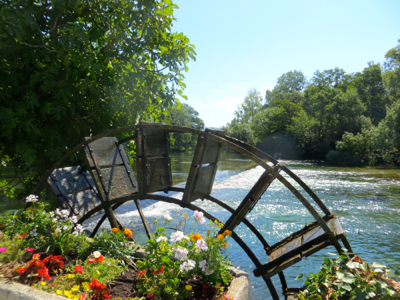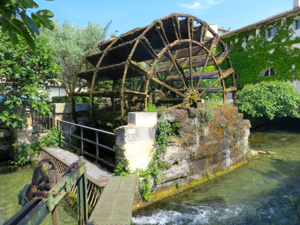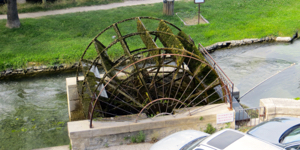 |
Water Wheels, L'Isle-sur-la-Sorgue | |
| These symbols of the town's past continue to distinguish it today. | ||
|
|
|
L'Isle-sur-la-Sorgue developed as an industrial town, taking advantage of the power provided by the Sorgue River to power water wheels and support local mills and factories. The wheels probably first powered corn mills, and later wool and silk. In 1855, records show that close to 300 workers were employed in 17 silk and wool mills in the town. Today 14 water wheels survive, and they add charm to modern L'Isle-sur-la-Sorgue. A walking tour, using a map available at the Tourist Information Office, provides a little background on some of the water wheels. Most were established by royal decree in the early 1800s, to support silk mills, wool spinning mills, or carding mills. Some provided water to essential facilities, such as the hospital or the monastery. Although most of the remaining water wheels are on the river or canal that form the central island, the "Partage des Eaux" wheel is about 1 kilometer (about 6/10 of a mile) to the east. Partage des Eaux is where the river divides into two arms. But this is no accidental dividing of the waters. In fact, the partage des eaux is based on a decree of 27 March 1852, enacted by Napoléon III. This decree specified that 5/12 of the water would go to one direction and 7/12 to the other, with the two branches called the Velleron and the L'Isle. Today there is a lovely park at the partage des eaux, as well as a couple of restaurants, and you can enjoy a picnic and the views, while watching canoes and kayaks on the river. And in fact, you can see the waters separate and go off in the two branches.
The water wheels are wonderful landmarks—we could see one from the window of our apartment—and the sound of the river and the water wheels adds to the calm and beauty of the town.
|
|
Above, One of the water wheels in L'Isle-sur-la-Sorgue.
|



